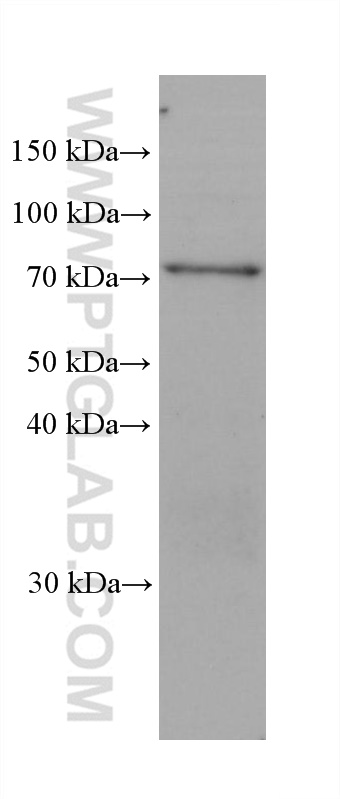验证数据展示
经过测试的应用
| Positive WB detected in | TT cells, hTERT-RPE1 cells, PANC-1 cells, HeLa cells |
推荐稀释比
| 应用 | 推荐稀释比 |
|---|---|
| Western Blot (WB) | WB : 1:5000-1:50000 |
| It is recommended that this reagent should be titrated in each testing system to obtain optimal results. | |
| Sample-dependent, Check data in validation data gallery. | |
产品信息
67194-2-Ig targets SHC1 in WB, ELISA applications and shows reactivity with human samples.
| 经测试应用 | WB, ELISA Application Description |
| 经测试反应性 | human |
| 免疫原 |
CatNo: Ag25173 Product name: Recombinant human SHC1 protein Source: e coli.-derived, PET28a Tag: 6*His Domain: 1-169 aa of NM_183001 Sequence: MDLLPPKPKYNPLRNESLSSLEEGASGSTPPEELPSPSASSLGPILPPLPGDDSPTTLCSFFPRMSNLRLANPAGGRPGSKGEPGRAADDGEGIVGAAMPDSGPLPLLQDMNKLSGGGGRRTRVEGGQLGGEEWTRHGSFVNKPTRGWLHPNDKVMGPGVSYLVRYMGC 种属同源性预测 |
| 宿主/亚型 | Mouse / IgG2b |
| 抗体类别 | Monoclonal |
| 产品类型 | Antibody |
| 全称 | SHC (Src homology 2 domain containing) transforming protein 1 |
| 别名 | SHC, 1A5B1, SH2 domain protein C1, SHC transforming protein 1, SHC-transforming protein 1 |
| 计算分子量 | 63 kDa |
| 观测分子量 | 66 kDa |
| GenBank蛋白编号 | NM_183001 |
| 基因名称 | SHC1 |
| Gene ID (NCBI) | 6464 |
| 偶联类型 | Unconjugated |
| 形式 | Liquid |
| 纯化方式 | Protein A purification |
| UNIPROT ID | P29353 |
| 储存缓冲液 | PBS with 0.02% sodium azide and 50% glycerol, pH 7.3. |
| 储存条件 | Store at -20°C. Stable for one year after shipment. Aliquoting is unnecessary for -20oC storage. |
背景介绍
The proto-oncogene SHC family consists of SHCA, SHCB, SHCC, and SHCD4 gene members, which can encode 7 kinds of cohesive molecules. SHC family is widely expressed and functional. The SHC1 gene is located in zone 1, region 2 of human chromosome 1. SHC1 is believed to be involved in inhibiting neuronal apoptosis and regulating the receptor tyrosine kinase pathway. SHC1 sensitizes cancer cells to the 8-Cl-cAMP treatment.
实验方案
| Product Specific Protocols | |
|---|---|
| WB protocol for SHC1 antibody 67194-2-Ig | Download protocol |
| Standard Protocols | |
|---|---|
| Click here to view our Standard Protocols |



